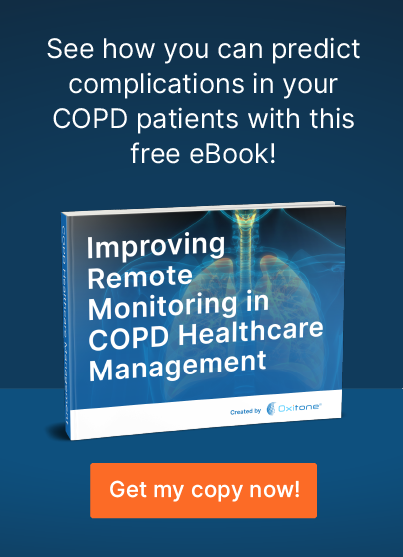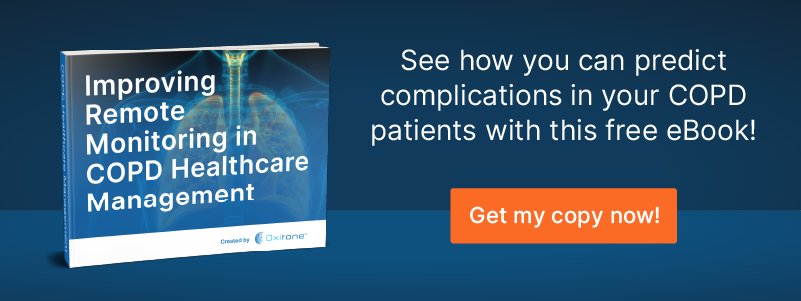Continuous remote patient monitoring revolutionizes the care of COPD patients
Remote monitoring of chronic obstructive pulmonary disease (COPD) patients presents new opportunities for caregivers and medical professionals to deliver the best in healthcare. Due to the nature of COPD symptoms, responsiveness is vital for addressing complications as they develop in real time. Shortness of breath due to hypoxia, elevated blood pressure spikes, and irregular sleep patterns are all complications of COPD and need to be addressed immediately to prolong a patient’s life and well-being.
Unfortunately, the limitations and risks of periodic (traditional) patient monitoring may not fully address these symptoms. But thanks to modern technology, continuous remote patient monitoring (CRPM) has set new standards and created more opportunities for better care for high-risk COPD patients.
Let’s look at the limitations of traditional remote monitoring and how CPRM integrates modern technology to revolutionize healthcare for high-risk COPD patients.
The Problems with Traditional Remote Monitoring for COPD Patients
Traditional remote patient monitoring (RPM) was initially developed as part of integrating emerging technology into the medical field to augment the capabilities of “telemedicine” (alternately referred to as “telehealth”). Physicians could collect data from patients through at-home testing devices or spot-check monitors, enhancing the previous methods of measuring vital signs and symptoms of COPD.
However, RPM’s benefits were outweighed by significant drawbacks that may have exacerbated high-risk COPD patients’ quality of life and affected the level of care that their physicians could provide. A 2017 study cited the dangers of traditional remote monitoring, outlining several reasons that traditional RPM negatively impacted COPD patients:
- Compatibility issues between available technology at outpatient and hospitals, leading to delays in data retrieval and/or a lack of continuity among recorded data
- Anxiety, stress, and panic induced from over-monitoring a patient’s health through self-diagnosis (this typically would lead to more expensive manual follow-ups, i.e., costly ER visits and hospitalizations, as well as overburdened healthcare providers)
- Lack of continuous data over a patient’s long-term health timeline and consistent monitoring (with COPD, symptoms can develop and worsen in a matter of minutes, potentially leaving patients susceptible to exacerbated conditions and even death)
- Compliance issues resulting from discomfort, lifestyle disruption, and negligence
How CRPM Replaces Traditional Remote Patient Monitoring
Early prediction and detection of complications for COPD patients lead to better outcomes, empowering caregivers and patients to get ahead of complications to save lives. CRPM fills in the gaps of traditional RPM due to leveraging the latest in technology integration and design features. The benefits of CRPM set it apart from other types of telemedicine, making it the more efficient tool for the remote monitoring of COPD patients and overall health management.
CPRM addresses the limitations of traditional remote monitoring in the following ways:
- Instantaneous data access and alerts: When it comes to COPD, every second counts. Patients need a prompt response to emergencies. CRPM wearable devices, like the Oxitone 1000M, have one-click data access and five levels of alert that respond in real time to alert patients to developing symptoms.
- Better patient engagement: CRPM wearables enable passive monitoring around the clock, while also offering easy access to patient data. This feature helps identify patient compliance issues. Similarly, physicians can have accurate data that develops over a verifiable timeline, leading to better strategies for event-based decision making, including exercise, poor air quality environments, and other behaviors.
- Facilitated seamless long-term care: Physicians need an easy and timely follow-up with patients. With physicians prescribing wearable CRPM devices, there are no interruptions or gaps in data during usage.
- Cost-effectiveness: CRPM devices can help lower admissions into hospitals and outpatient facilities by catching trends before they become complications, which reduces overall healthcare costs from hospitalizations, unnecessary treatments, etc.
- Peace of mind: CRPM devices generate medical-grade physiological data that patients can use for clinical decisions and overall peace of mind. With informed patients actively engaged in their healthcare through continuous monitoring, patients can optimize overall activity and monitor their events for better health outcomes.
Oxitone Delivers the Best in Modern Continuous Remote Patient Monitoring for COPD
If you are looking to integrate the latest advances in telemedicine, the Oxitone 1000M enables the best remote monitoring of COPD patients.
- Early detection: The Oxitone 1000M offers continuous monitoring specifically designed for the prediction and early detection of complications for COPD patients.
- FDA-cleared medical device: As the first device of its kind, the Oxitone 1000M is officially approved by the Food and Drug Administration as a wearable RPM device designed for accurate usage for high-risk COPD patients.
- Comfort and wearability: Oxitone 1000M is a wearable medical device first and foremost, differentiating its purpose, medical accuracy, and technology from general-usage wearables like the Apple Watch, Garmin, and others. Its elastic FlexSense™ optical aperture embraces the ulna bone and doesn’t affect a local blood flow for high medical-grade accuracy. This enhanced usability and reliability provide superior comfort and monitoring continuity for better patient compliance.
- Compatibility: Recognizing new technological trends in medical applications, patients who need to transfer data to analysis platforms can choose two methods:
- Enable API/ Bluetooth integration (direct integration of the Oxitone 1000M device into their platform via BLE).
- Integrate Oxitone cloud platform into their platform via secure API.
- Ease of data access: The real-time data doesn’t have the data and monitoring complications that are common in other COPD-detection devices available on the market.
- Intuitive alerts: The 1000M generates smart notifications that require five levels of verification before initiating an alert. It never disturbs with false or random alerts.
- Capabilities: It continuously measures:
- SpO2
- Pulse rate
- Heart rate variability (physiological stress)
- Activity
- Skin temperature
- Sleep apnea and disorders
- Respiratory rate
- Fall detection
- Hypoxia index
- Physiological stress
- Behavior data
- Sleep apnea
- Occupational health
- Activity and stress
- General baseline
For more information about the Oxitone 1000M, visit Oxitone’s homepage to learn about its role in treating COPD for at-risk patients.
Here at Oxitone, we boost value-based healthcare by delivering extraordinary patient, clinical, and economical outcomes at reduced medical utilization and cost. Patients need a prompt response to emergencies. Physicians need an easy and timely follow-up with patients. Our mission is to transform chronic disease management and help save lives worldwide.
Let’s save lives together! To see how we help remote patient monitoring companies and physicians improve the management and care of high-risk patients, contact us today!


